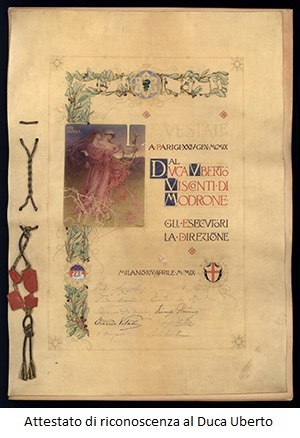- Milano
- “Mario Romani” Department of Economic and Social History and Geographical Sciences
- Archivio Visconti di Modrone
- I fondi
- Società anonima per l'esercizio dei Teatri alla Scala e Canobbiana
Società anonima per l'esercizio dei Teatri alla Scala e Canobbiana
1815-1922
 The section was recently created by separating the documentation of the company from that of the family archive, the Theatre Businesses series, and from the papers under the names of Guido and Uberto Visconti, i.e. the sub-series
The section was recently created by separating the documentation of the company from that of the family archive, the Theatre Businesses series, and from the papers under the names of Guido and Uberto Visconti, i.e. the sub-series
Duca Guido, Oggetti particolari, Teatro alla Scala 1898-1902 and Duca Uberto, Oggetti particolari, Teatro alla Scala 1898-1926
The relationship between the Visconti and the theatrical milieu of Milan was very close from the last decades of the 18th century onward, the result of both the lively artistic, social and cultural interests of the family (the Visconti owned one of the most prestigious stages of La Scala and would later acquire others) and more strictly entrepreneurial motives.
It was originally Duke Carlo who managed the Milanese theatres between 1828 and 1830; at the end of his tenure, in 1830, an important modernization and restoration project was carried out at La Scala. Between 1832 and 1837 Carlo Visconti directly took over the management of the Teatro alla Scala, first as guarantor of the contractor Teodoro Gottardi, later as an impresario. The Count's death in 1836 interrupted the contract, which passed to the heirs and was then sold off. Even if the passion for music and theatre was cultivated by many members of the family, it wasn't until the end of the century that a Visconti would be directly involved in the management of the most important theatre in the city. In 1898, the Società Anonima per l’esercizio del Teatro alla Scala was established, of which Duke Guido Visconti di Modrone was among the most generous contributors and first president (the vice-president was Arrigo Boito).
For many seasons, the city's opera houses (including the Cannobiana, which was renovated in 1894 and renamed Teatro Lirico) had been facing a difficult economic and administrative crisis due to the lack of subsidies from the Comune di Milano and the low income of private stage owners, the so-called "palchettisti". The non-profit Società offered to not only to resolve the finances of a theatre that had been temporarily forced to close, but also to restore cultural dignity to an institution of great importance to the city. The courageous choices of the new management, both administratively and artistically (the new director was the young Arturo Toscanini), contributed to the success of La Scala as a "temple" of music and to the renewal of the Italian opera house. After the death of Duke Guido in 1902, his role was taken over with renewed commitment and the same purpose by his son Uberto, even if the Società Anonima was transformed into a sort of "operational group" of private citizens and palchettisti. The First World War forced Count Uberto, who had left for the front, to rescind the contract for the management of the theatre in 1917. In 1920, the Ente Autonomo della Scala was established.
 The documentation consists of 11 folders of correspondence and 127 registers, dating from 1815 to 1922.
The documentation consists of 11 folders of correspondence and 127 registers, dating from 1815 to 1922.
In addition to the usual administrative documents, the folders include valuable testimony of the opera and theatre world not only in Milan but in Italy and abroad: contracts with artists, posters of the shows, business cards of politicians of the Kingdom, lists of choreographers, equipment, professionals and singers, correspondence with exponents of the Italian music world and with publishing houses, brochures and newspapers of the period. Some dossiers are dedicated to the management of Teatro Alla Scala and Cannobiana Theatre in the first decades of the 19th nineteenth century. Records include membership books and contributor lists, meeting minutes, receipts (the so-called borderòs), writings, contracts, and three volumes of press reviews. The collection has an inventory.
“Mario Romani” Department of Economic and Social History and Geographical Sciences
- About us
- Research Projects
- Teachings A.Y. 2025/2026
- MASTER
- PhDs
- Department Publications
- Events
- Other Initiatives
- International Area
- Department Library
- Archivio per la Storia del movimento Sociale Cattolico in Italia «Mario Romani»
- Archivio Visconti di Modrone
- Associazione Duca Marcello Visconti di Modrone per la storia dell’industria
- I fondi
- Serie antiche
- Serie ottocentesche per materia
- Serie ottocentesche ad personam
- Famiglia Anguissola di Grazzano
- Famiglia Taverna
- Altre serie
- Opera Pia Visconti di Modrone
- Pio Istituto Teatrale di Milano
- Stabilimento Velluti Visconti di Modrone - Velvis
- Società anonima per l'esercizio dei Teatri alla Scala e Canobbiana
- Struttura del complesso
- Come accedere all'Archivio
